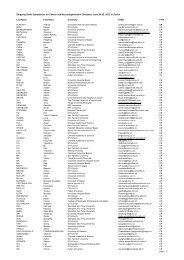Stepping Stone Symposia Conference on Medical Technology ...
Stepping Stone Symposia Conference on Medical Technology ...
Stepping Stone Symposia Conference on Medical Technology ...
Create successful ePaper yourself
Turn your PDF publications into a flip-book with our unique Google optimized e-Paper software.
Jian JI<br />
Zhejiang University<br />
jijian@zju.edu.cn<br />
SSSTC <str<strong>on</strong>g>Stepping</str<strong>on</strong>g> <str<strong>on</strong>g>St<strong>on</strong>e</str<strong>on</strong>g> Symposium <strong>on</strong> <strong>Medical</strong> Technologies, 27–28 September 2012<br />
Research interests<br />
Surface modificati<strong>on</strong> for cardiovascular device; c<strong>on</strong>structi<strong>on</strong> of bio-functi<strong>on</strong>al multilayer coating via layer-by-layer<br />
self-assembly; bio-inspired surface engineering of nano-carrier for nano-medicine<br />
Educati<strong>on</strong>al history<br />
Prof. Ji Jian received his Ph.D. degree in Polymer Science from Zhejiang University in 1997. He was a postdoctoral<br />
fellow at Nati<strong>on</strong>al Institute of Biomedical Engineering, Porto, (INEB) between 1998 and 2000 and a visit scientist at<br />
Institute of Applied Physical Chemistry, University of Heidelberg between 2003 and 2004.<br />
Previous positi<strong>on</strong>s<br />
Since 2008, he has been vice director of the Institute of Biomedical Macromolecule in Zhejiang University. In 2010,<br />
he received the Distinguished Young Scholars Award of the Nati<strong>on</strong>al Science Foundati<strong>on</strong> of China.<br />
Jian Ji<br />
Layer-by-layer assemble as a robust technique to mimic basement membrane for in situ<br />
endothelializati<strong>on</strong> of cardiovascular stent<br />
Cardiovascular biomaterials; biomimic, surface treatment; layer-by-layer assembles<br />
The in-stent restenosis (ISR) and the late stent thrombosis (LAST) represent the most comm<strong>on</strong> failures of stent<br />
implantati<strong>on</strong> and are both mediated at the injured endothelium. The natural endothelium healing mechanism<br />
provides an approach to achieve in situ endothelializati<strong>on</strong> of the implant by stimulating the neighboring<br />
endothelial cells (ECs) migrati<strong>on</strong> or capturing the circulating endothelial cells (CEC) directly from the blood<br />
circulati<strong>on</strong>. The basement membrane is a thin layer of basal or reticular lamina that supports the endothelium and<br />
modulates the vessel repair. It is a multilayered hybrid self-assemble via different biomacromolecules, which is<br />
biodegradable and be able to c<strong>on</strong>trol release of bioactive different growth factor to modulate the competiti<strong>on</strong><br />
between endothelial cells and smooth muscle cells. And the micro-nanostructure and the stimuli-resp<strong>on</strong>sive<br />
mechanical properties of substrates also c<strong>on</strong>tribute a lot to achieve a highly specific guide of ECs in vivo.<br />
Layer-by-layer self-assembly technique, with advantages of easy preparati<strong>on</strong>, retainable biomacromolecules’<br />
activity, and adaptable to substrates with whatever size and shape, has increasingly been used to immobilize<br />
biomacromolecules <strong>on</strong>to the vascular prostheses and tissue engineering scaffolds to improve their<br />
hemocompatibility or cytocompatibility respectively. Our recently research dem<strong>on</strong>strated that the multilayered<br />
assemblies can be further explored as a versatile platforms for mimic the basement membrane structures and<br />
functi<strong>on</strong>alities, which has been expend to fabricate a novel cardiovascular stent with excellent in situ<br />
Endothelializati<strong>on</strong> and anti-restenosis.<br />
Page | 30



